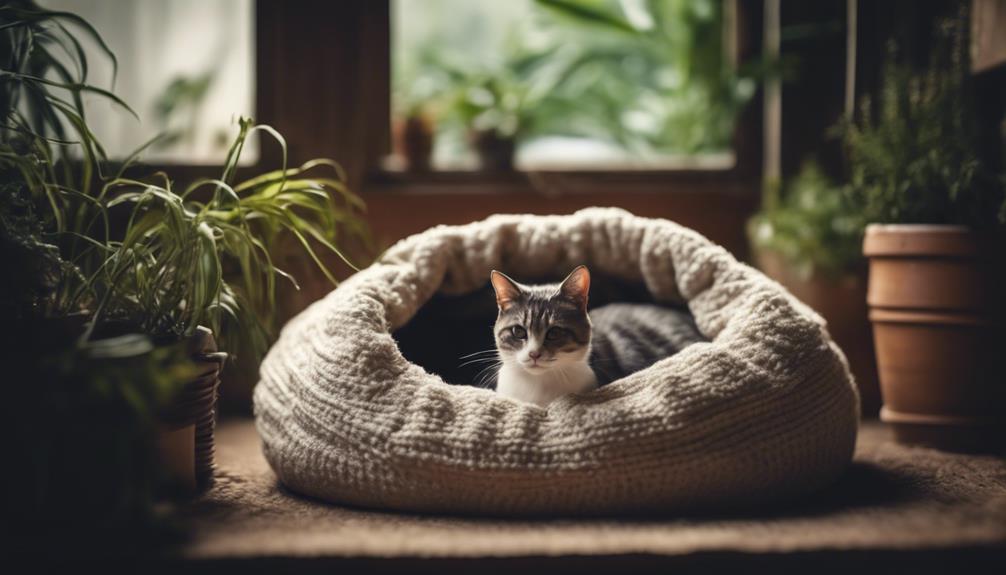What to Do if Your Cat Is Fearful of Strangers

Is your cat fearful or anxious around strangers? It can be challenging to help your feline friend feel more comfortable in social situations. However, with patience and the right approach, you can make a positive difference in your cat's behavior. Here are some tips and strategies to help your fearful cat with strangers:
- Create a Safe Space: Provide your cat with a designated safe space where they can retreat to when they feel overwhelmed. This could be a quiet room with their favorite toys, bed, and litter box.
- Gradual Exposure: Gradually expose your cat to strangers in a controlled environment. Start with familiar faces and slowly introduce new people over time. Use treats and positive reinforcement to create a positive association with strangers.
- Respect Your Cat's Boundaries: It's essential to respect your cat's boundaries and not force them to interact with strangers if they're not comfortable. Allow your cat to approach new people at their own pace.
- Use Pheromones: Consider using pheromone diffusers or sprays to help calm your cat in stressful situations. These products can help reduce anxiety and create a sense of security for your cat.
- Consult a Professional: If your cat's fearfulness around strangers is severe and impacting their quality of life, consider seeking help from a professional animal behaviorist. They can provide personalized guidance and support to help your cat overcome their fear.
By implementing these tips and strategies, you can help your fearful cat feel more at ease around strangers and improve their overall well-being. Remember to be patient and understanding, as overcoming fear takes time and consistency.
Understanding Your Cat's Behavior
Understanding your cat's behavior can greatly assist in identifying the root causes of their fear towards strangers. By observing their body language cues, such as flattened ears, dilated pupils, or a twitching tail, you can start to decipher when your cat is feeling anxious or scared. This awareness is crucial in implementing effective socialization techniques to help your cat feel more comfortable around unfamiliar faces.
Building trust with your cat is key in addressing their fear of strangers. Take small steps to create positive associations by offering treats or engaging in playtime when new people are around. Consistency and patience are vital in this process. Additionally, desensitization methods can be beneficial. Gradually exposing your cat to strangers in a controlled environment, while ensuring they feel safe and secure, can help them become more accustomed to unfamiliar individuals over time.
Providing Safe Spaces at Home

To help your fearful cat feel more secure around strangers, ensure your home provides safe spaces where they can retreat and relax. Creating boundaries and building trust are essential steps in helping your cat feel more at ease in their environment. Here are some practical tips to consider:
- Designated Safe Zones: Set up quiet areas in your home where your cat can escape to when they feel overwhelmed.
- Comfortable Hideaways: Provide hiding spots such as cat condos, igloos, or cozy blankets for your cat to feel secure.
- Vertical Space: Cats feel safer when they can observe from an elevated position, so offer cat trees or shelves for climbing.
- Soothing Scents: Use pheromone diffusers or calming sprays to create a relaxing atmosphere in their safe spaces.
- Respect Boundaries: Ensure visitors know not to intrude on your cat's safe zones to help them feel more in control of their environment.
Gradual Exposure to Strangers

When helping a fearful cat adjust to strangers, gradually exposing them to new individuals in a controlled and comforting environment can build their confidence and reduce anxiety. Desensitization training and socialization techniques are essential in this process.
Start by having the cat in a separate room and slowly introduce them to the scent of the new person through an item like clothing. Once the cat seems comfortable, allow them to see the stranger from a distance.
Trust building exercises, such as having the stranger offer treats or engage in gentle play, can help the cat associate positive experiences with the new person. Confidence building strategies like providing hiding spots or vertical spaces where the cat can observe without feeling threatened are also beneficial.
Positive Reinforcement Techniques

To help a fearful cat adjust positively to strangers, implementing effective positive reinforcement techniques is crucial in fostering trust and building confidence. Positive reinforcement techniques focus on rewarding desirable behaviors to encourage their repetition. Here are some practical strategies to help your cat feel more at ease around strangers:
- Clicker training: Use a clicker to mark moments when your cat displays calm behavior around strangers, followed by treats to reinforce this positive action.
- Treats: Offer your cat tasty treats when they show signs of relaxation or curiosity in the presence of strangers.
- Desensitization: Gradually expose your cat to strangers in a controlled environment, starting from a distance and slowly decreasing the space over time.
- Counterconditioning: Pair the presence of strangers with something your cat enjoys, such as playtime or treats, to create positive associations.
- Patience and consistency: Be patient with your cat's progress and consistently reward calm behavior to reinforce positive interactions with strangers.
Using Pheromone Products

Using pheromone products can be an effective way to help calm and reassure a fearful cat in the presence of strangers. Pheromones are natural chemicals that cats release, and synthetic versions can be used to create a sense of security and reduce anxiety in felines. These products come in various forms such as diffusers, sprays, and collars, making it convenient for cat owners to choose what works best for their pet. Below is a table outlining the benefits and misconceptions of using pheromone products:
| Benefits | Misconceptions | Product Effectiveness | Alternatives |
|---|---|---|---|
| Helps calm the cat | Not effective for all | Varies based on the | Behavioral training, |
| Reduces anxiety levels | cats | individual cat | natural remedies |
| Easy to use | Expensive | May take time to show | Comfortable hiding |
| Safe for cats | Quick fix solution | results | spots in the home |
While pheromone products can be beneficial, they may not work for every cat. It's essential to consider them as part of a holistic approach to help your cat feel more at ease around strangers.
Seeking Professional Help

Consider consulting a qualified veterinarian or animal behaviorist to address your cat's fearful behavior around strangers. These professionals can provide valuable insights and guidance tailored to your cat's specific needs, helping you create a safe and comfortable environment for your feline friend. Here are some key points to keep in mind when seeking professional help:
- Behavior Modification: Professionals can recommend behavior modification techniques to help your cat feel more at ease around strangers.
- Professional Guidance: Veterinarians and animal behaviorists can offer personalized guidance on how to approach and interact with your cat to build trust and confidence.
- Creating a Customized Plan: They can help you develop a customized training plan that suits your cat's temperament and triggers.
- Medication Options: In severe cases, professionals may suggest medication to manage your cat's anxiety in conjunction with behavior modification.
- Follow-Up Support: Regular follow-up sessions can ensure that the treatment plan is effective and make any necessary adjustments.
Seeking professional help is a proactive step towards helping your cat overcome its fear of strangers.
Consistency and Patience in Training

For successful training outcomes, maintaining consistency and practicing patience are key factors in helping your fearful cat adjust to strangers. Building trust with a fearful cat takes time and effort. It's essential to create a predictable environment for your cat by sticking to a routine. Consistency in your actions and interactions will help your cat feel more secure and less anxious around strangers.
Training a fearful cat to be comfortable with strangers can be a slow process. It's crucial to be patient and not rush the training. Pushing your cat too quickly can cause setbacks and increase their fear. By taking small steps and gradually exposing your cat to new people, you can help them build confidence at their own pace.
Remember to reward positive behavior and provide reassurance during training sessions. Be understanding of your cat's feelings and reactions. With time, consistency, and patience, you can help your fearful cat make progress and become more comfortable around strangers.
Frequently Asked Questions
Can I Use Medication to Help My Cat Feel More Comfortable Around Strangers?
While medication can help some cats, there are also behavioral therapy, training techniques, and socialization methods that can be effective in making a cat feel more comfortable around strangers. It's important to consult with a vet for guidance.
Are There Any Specific Breeds of Cats That Are More Prone to Being Fearful of Strangers?
Some cat breeds exhibit a genetic predisposition towards being more fearful of strangers. However, with proper socialization techniques, behavioral training, and environmental enrichment, these tendencies can be managed effectively to help the cat feel more comfortable around unfamiliar individuals.
How Can I Help My Cat Feel More Comfortable Around Strangers When They Come to Visit Unexpectedly?
To help a cat feel at ease around strangers, consider using training techniques like behavior modification and positive reinforcement. Creating an enriched environment can also aid in reducing fear levels, making interactions more comfortable for all involved.
Is It Possible for My Cat to Become Less Fearful of Strangers as They Get Older?
Cats can become less fearful of strangers as they age through gentle exposure and positive reinforcement. Training techniques, socialization methods, desensitization exercises, and behavior modification can all help in gradually building their confidence and reducing fear.
Are There Any Specific Body Language Cues That Indicate My Cat Is Feeling Fearful Around Strangers?
Noticing fear in cats around strangers involves observing body language cues like flattened ears, dilated pupils, and a tense body posture. Understanding aggression triggers and recognizing stress signals can help caretakers create a safe, reassuring environment for their feline companions.











